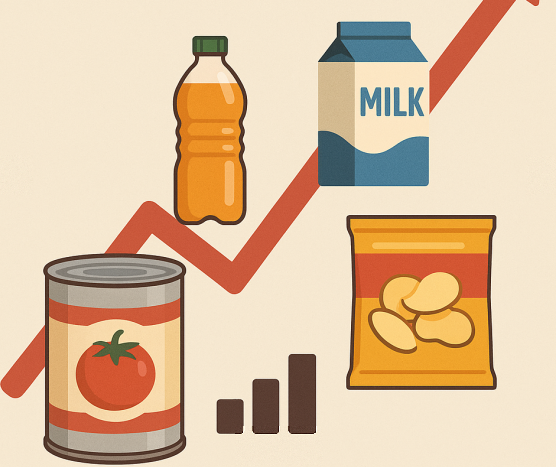Household Products: after a recovery in 2024, which high-potential destinations for sectoral exporters?
Salone del Mobile (Milan/Italy) kicks off: opportunities from growing international markets
Published by Silvia Brianese. .
Uncertainty Foreign markets Home items Foreign market analysisIn 2024, return to growth in world trade of Household Products both in euro values...
Last year, world trade of finished household products1, after having recorded a drop of almost 6 percentage points in euro values in 2023, returned to growth (+2.1%, according to the ExportPlanning pre-estimates), reaching 751 billion euros (+34.3 percent higher than pre-pandemic values).
.. and in the measurement at constant prices.
It should also be highlighted that, after a two-year period 2022-2023 in which world trade in finished household products measured in quantities (at constant prices) had shown a decline (overall equal to over 10 percentage points), last year the evolution of world trade measured at constant prices showed a average annual result of significant recovery (+6.8%), although not fully recovering the maximum levels of 2021.
The 2024 recovery involved almost all the main sectors
of the Household Products industry
Last year, almost all the main sectors of the finished household products analyzed - with the exception of Lighting Technology - showed a recovery in the pace of development of international trade in the measurement at constant prices.
In particular, the greatest accelerations involved the sectors Home Appliances (with world trade increasing by +12% compared to 2023 if measured at constant prices), Home Textiles (+10.5% compared to 2023 at constant prices), Furniture and Furnishing (+5.7%) and Consumer Electronics (+5.2%). On the other hand, global trade in Lighting Technology showed a new Year-over-Year decline - both in terms of constant prices (-5%) and also in nominal values in euros (-4.4%).
World trade in finished household products
| Values 2024E | % changes at current prices |
% changes at constant prices |
|||
| Sector | (Bn €) | 2024/2023 | 2024/2019 | 2024/2023 | 2024/2019 |
| Home Appliances | 187.1 | + 7.0 | +34.3 | +12.0 | +17.9 |
|---|---|---|---|---|---|
| Consumer Electronics | 181.5 | - 1.5 | +16.8 | + 5.2 | +12.9 |
| Furniture and Furnishings | 94.5 | + 1.9 | +23.8 | + 5.7 | + 6.6 |
| Lighting technology | 54.6 | - 4.4 | + 7.6 | - 5.0 | -16.3 |
| Home Textiles | 45.9 | + 1.5 | +15.4 | +10.5 | +14.0 |
| Other household products | 187.3 | + 3.6 | +31.2 | + 7.5 | +16.6 |
| TOTAL | 750.9 | + 2.1 | +24.2 | + 6.8 | +10.8 |
Source: ExportPlanning-Annual Trade Flows Datamart
Although improving, the international outlook of the Household products industry still appears far from solid
The growth profile of world exports of finished household products, shown in the graph above, shows a progressive strengthening (with the last quarter of last year marking a trend increase in global sales of the sector of over 8 percentage points when measured at constant prices).
However, the sectoral and, above all, geographical profile of growth still appears uneven. Proof of this is the fact that global exports of the Lighting Technology2 and Consumer Electronics3 sectors were still in negative territory until Q3-2024; uncertain trends also characterized the first part of 2024 for global exports of Furniture and Furnishings4; only the Home Appliances5 and Home Textiles6 sectors have maintained a favorable outlook since the first part of last year.
At a geographical level, while it is true that all the main areas have offered positive contributions to the 2024 performance of global demand for the Household Products industry, it should be highlighted that relevant markets - such as Germany, France, United Kingdom in Europe7, China and Hong Kong, India and Japan outside Europe - still show lower demand levels than pre-pandemic levels, measured at constant prices.
Household Products' Markets in the Growth Phase: some Case-Studies
By analyzing the life cycle of imports according to the methodology outlined in the article "Machine learning to identify the most promising foreign markets", it is possible to identify the markets that currently present the greatest growth potential for the export of finished household products.
In particular, the countries with the largest number of products whose imports are in a growth phase are Vietnam, Philippines, Azerbaijan and Saudi Arabia.
The following table shows the number of products in a growth phase imported by the four countries considered, divided by the most relevant sectors of the Household Products industry for European exports.
Number of products according to the Harmonized System (HS) classification
identified, for each country, in the phase of import growth
| Furniture and Furnishings | Lighting Technology | Domestic Appliances | Home Textiles | Sum of Sectors | |
| Vietnam | 11 | 3 | 5 | 22 | 41 |
|---|---|---|---|---|---|
| Philippines | 6 | 2 | 1 | 7 | 16 |
| Azerbaijan | 1 | 5 | 6 | 2 | 14 |
| S-Arabia | 3 | 2 | 1 | 3 | 9 |
Source: StudiaBo on ExportPlanning Information System
The above findings can be explained by several economic and institutional factors.
On the one hand, Vietnam and Philippines are experiencing an increase in middle-class income, which translates into greater demand for high value-added goods, including those in the home sector.
On the other hand, Azerbaijan and Saudi Arabia are experiencing a significant increase in investments in the real estate sector, thus fueling demand for furniture and home products.
The results in the table are further confirmed by the analysis of the historical series of imports for each sector of the Home System, focusing on the countries with the largest number of growing products.
In particular, Vietnam and Philippines emerge as growing markets for furniture and furnishing elements imports, especially for plastic, bamboo and wicker furniture, convertible seats and mattresses.
Furniture and furnishing elements: Vietnam and Philippines imports
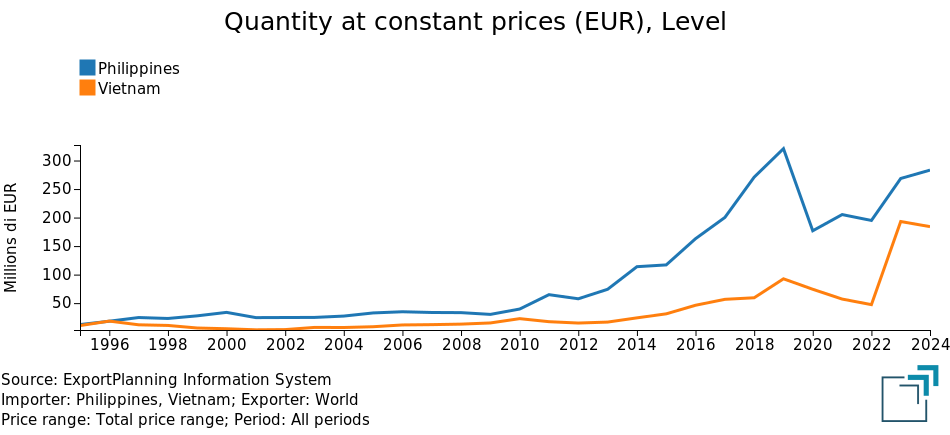
In the Lighting Technology sector, Philippines and Azerbaijan emerge as the markets with the highest number of products experiencing import growth, with increasing demand especially for LEDs and lamps.
Lighting Technology: imports of Azerbaijan and the Philippines
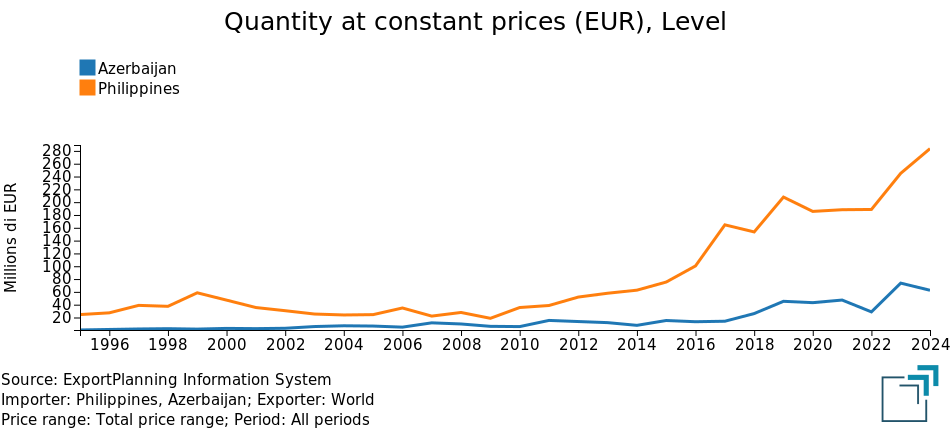
In the Home Appliances sector, Vietnam and Azerbaijan are considered emerging markets especially in the imports of dishwashers, vacuum cleaners, microwave ovens and toasters.
Home Appliances: imports of Vietnam and Azerbaijan
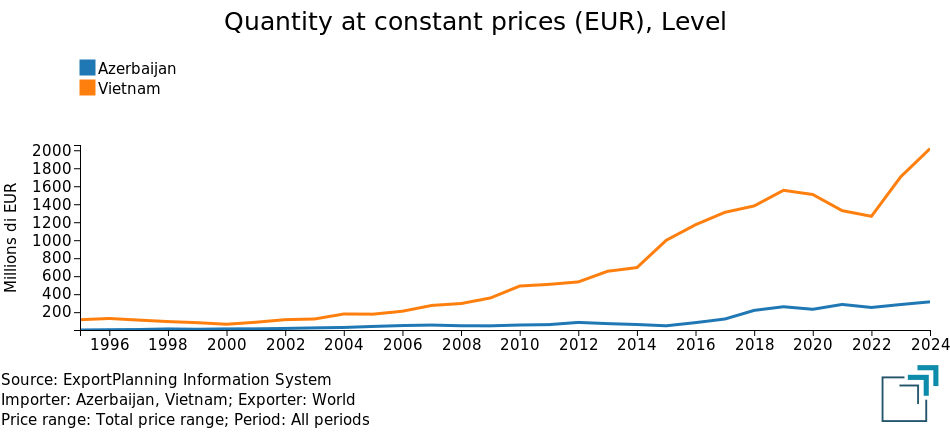
Finally, regarding the Home Textiles sector, the markets with the largest number of products in the growth phase of imports are Vietnam and Philippines. These products mainly concern bed linen, table linen, toilet linen or kitchen linen, curtains, mosquito nets, blankets and bedspreads.
Home Textiles: imports of Vietnam and Philippines
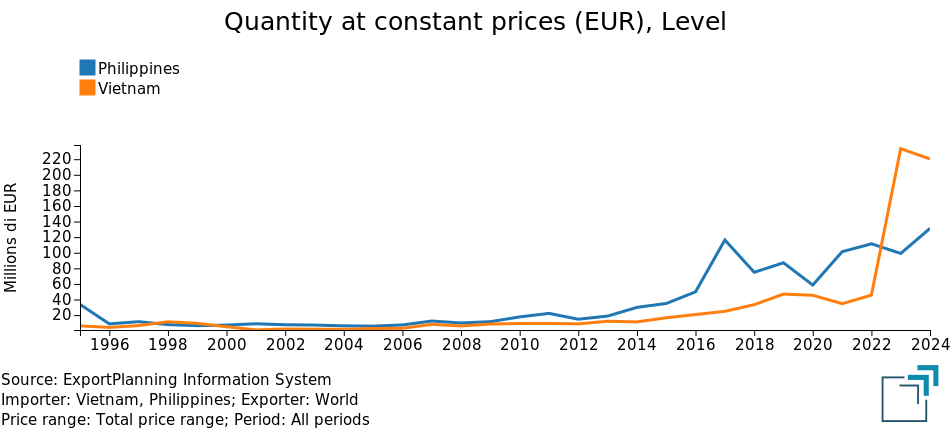
Finally, although the overall number of products in the growth phase of Saudi Arabia imports is lower than that of the other three countries, the latter stands out in particular for a significant increase in imports of toilet linen or kitchen linen, as highlighted in the graph below.
Toilet linen or kitchen linen: Saudi Arabia's imports
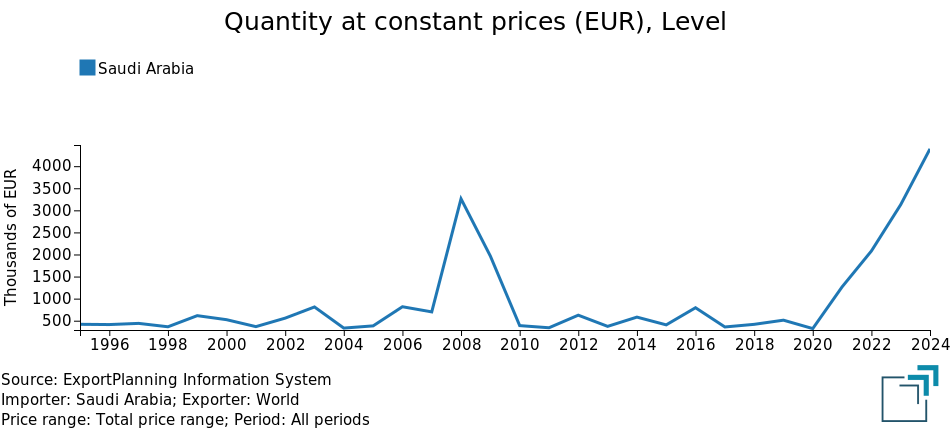
Conclusions
The 2025 edition of Salone del Mobile is about to start, for the industry of the Household Products, in a context of renewed growth, but rather selective.
In fact, the global demand for finished products for the home has shown signs of recovery during 2024, albeit uneven in terms of product and especially geography.
In such a scenario (expected to remain so in the near future), it is particularly important for companies in this industry to identify and develop those foreign markets that - thanks to a phase of structural acceleration - are in a position to offer greater possibilities for growth ideas.
These markets are typically characterized by the supply of new producers, investments in logistics and distribution and imitative effects in consumer behavior that lead to the start of a path of accelerated growth in imports.
For an exporter who has to operate in a context of uncertainty and increased selectivity, these are certainly favorable conditions because they are markets in which the demand for foreign producers is growing at high rates.
By applying machine learning techniques to classify markets in different stages of development of imports of a given product/sector/industry, ExportPlanning can help exporters to identify the markets with the greatest growth potential in the near future.
1) For a list of the sectors analysed, please refer to the relevant industry description.
2) In the first three quarters of 2024, world exports of Lighting Technology remained in negative territory, showing a moderately positive profile only in the final part of the year.
3) In the first nine months of 2024, global exports of Consumer Electronics showed negative trends, showing a positive profile only in the last quarter of the year.
4) In the first three quarters of last year, global exports of Furniture and Furnishings recorded moderate growth overall, which only marginally improved in the last quarter of the year.
5) In During 2024, global exports of Home Appliances have been able to show a progressive strengthening, reaching double-digit trend growth in the second half of the year when measured at constant prices.
6) In 2024, global exports of Home Textiles have been able to show a constant growth profile when measured at constant prices, with a further acceleration in the final part of the year, testifying to a particularly favorable sector context.
7) Overall, in the period 2020-2024, imports of these three European markets (Germany, France and UK) have shown a decrease of 2.2 billion euros when measured at constant prices.
8) Overall, in the period 2020-2024, imports of these four Asian markets (China, Hong Kong, India and Japan) recorded a drop of 8.6 billion euros in constant price measurement (equal to -23.2%).
